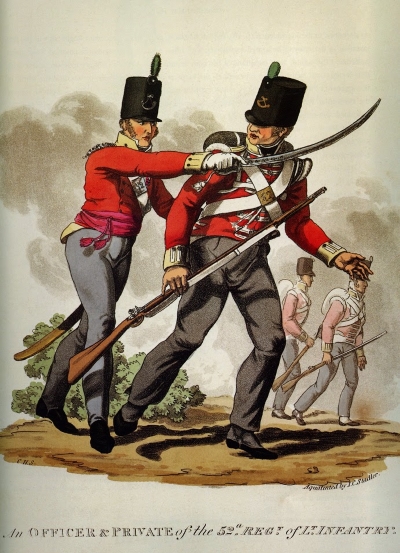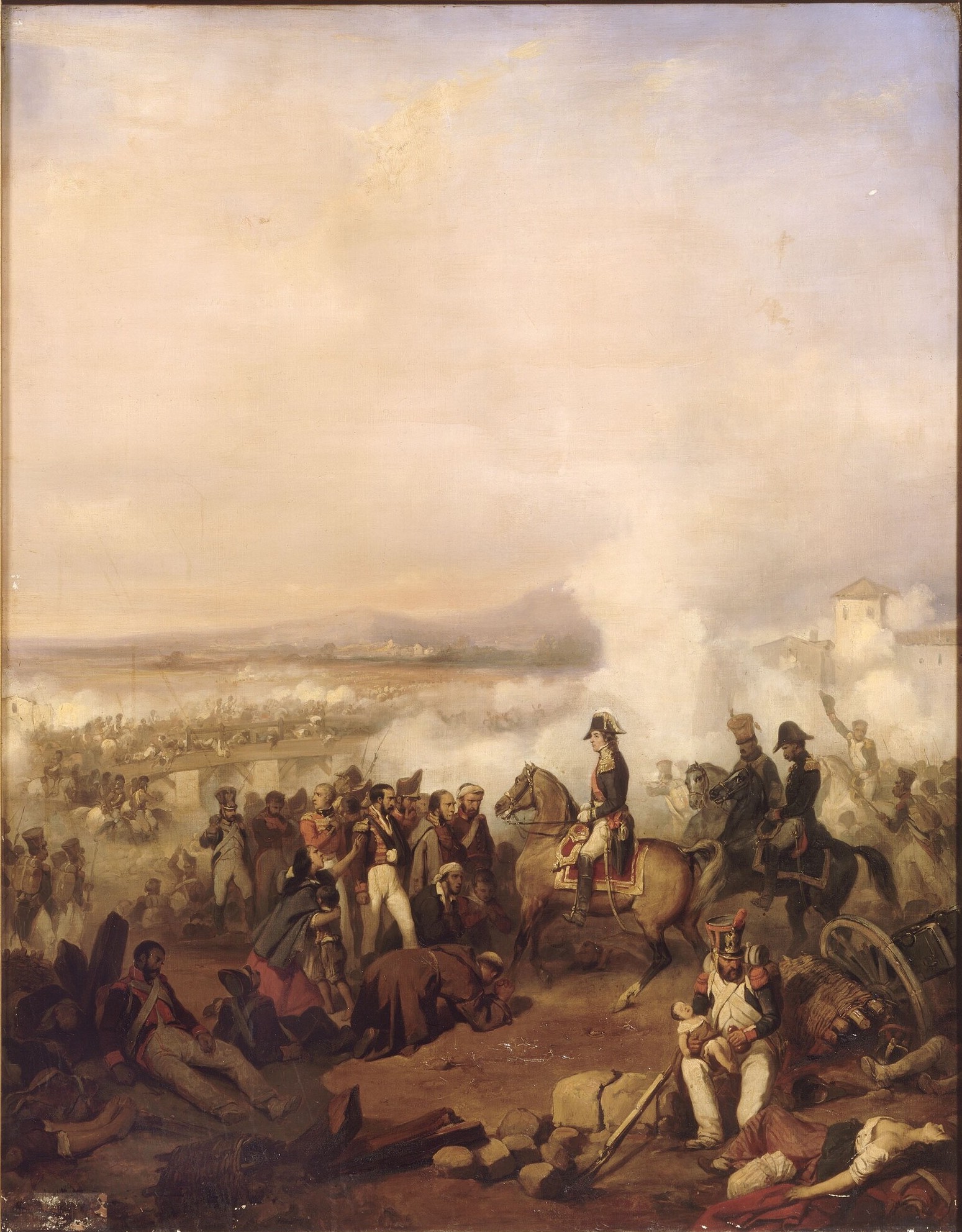|
Battle Of Nivelle
The Battle of Nivelle (10 November 1813) took place in front of the river Nivelle near the end of the Peninsular War (1808–1814). After the Allied siege of San Sebastian, Wellington's 80,000 British, Portuguese and Spanish troops (20,000 of the Spaniards were untried in battle) were in hot pursuit of Marshal Soult who had 60,000 men to place in a 20-mile perimeter. After the Light Division, the main British army was ordered to attack and the 3rd Division split Soult's army in two. By two o'clock, Soult was in retreat and the British in a strong offensive position. Soult had lost another battle on French soil and had lost 4,500 men to Wellington's 5,500. Background In the Siege of San Sebastian, the Anglo-Portuguese stormed and captured the port at the beginning of September 1813. In the Battle of San Marcial on 31 August, Soult failed to break through the Spanish defences in his final attempt to relieve the siege. The French army then fell back to defend the Bidassoa ... [...More Info...] [...Related Items...] OR: [Wikipedia] [Google] [Baidu] |
Peninsular War
The Peninsular War (1807–1814) was the military conflict fought in the Iberian Peninsula by Spain, Portugal, and the United Kingdom against the invading and occupying forces of the First French Empire during the Napoleonic Wars. In Spain, it is considered to overlap with the Spanish War of Independence. The war started when the French and Spanish armies invaded and occupied Portugal in 1807 by transiting through Spain, and it escalated in 1808 after Napoleonic France occupied Spain, which had been its ally. Napoleon Bonaparte forced the abdications of Ferdinand VII and his father Charles IV and then installed his brother Joseph Bonaparte on the Spanish throne and promulgated the Bayonne Constitution. Most Spaniards rejected French rule and fought a bloody war to oust them. The war on the peninsula lasted until the Sixth Coalition defeated Napoleon in 1814, and is regarded as one of the first wars of national liberation. It is also significant for the emergence of larg ... [...More Info...] [...Related Items...] OR: [Wikipedia] [Google] [Baidu] |
Light Division
The Light Division was a light infantry division of the British Army. Its origins lay in "Light Companies" formed during the late 18th century, to move at speed over inhospitable terrain and protect a main force with skirmishing tactics. These units took advantage of then-new technology in the form of rifles, which allowed it to emphasise marksmanship, and were aimed primarily at disrupting and harassing enemy forces, in skirmishes before the main forces clashed. Formed in 1803, during the Napoleonic Wars, the Light Division was raised thrice thereafter: during the Crimean War, the First World War and from 1968 to 2007. Some light infantry units remained outside the Light Division. Origins of the Light Division The British Army's first three "Rifle Battalion" was raised by the 60th (Royal Americans) in 1797–99. The command of this first rifle battalion was given to Francis de Rottenburg, who had extensive experience with light infantry. While the 60th did not officially be ... [...More Info...] [...Related Items...] OR: [Wikipedia] [Google] [Baidu] |
Flanking Maneuver
In military tactics, a flanking maneuver is a movement of an armed force around an enemy force's side, or flank, to achieve an advantageous position over it. Flanking is useful because a force's fighting strength is typically concentrated in its front, therefore, to circumvent an opposing force's front and attack its flank is to concentrate one's own offense in the area where the enemy is least able to concentrate defense. Flanking can also occur at the operational and strategic levels of warfare. Tactical flanking The flanking maneuver is a basic military tactic with several variations. Flanking an enemy entails attacking from one or more sides, at an angle to the enemy's direction of engagement. There are three standard flanking maneuvers. The first maneuver is the ambush, where a unit performs a surprise attack from a concealed position. Units friendly to the ambushing unit may be hidden to the sides of the ambush site to surround the enemy, but care must be taken in ... [...More Info...] [...Related Items...] OR: [Wikipedia] [Google] [Baidu] |
Soult
Marshal General Jean-de-Dieu Soult, 1st Duke of Dalmatia, (; 29 March 1769 – 26 November 1851) was a French general and statesman, named Marshal of the Empire in 1804 and often called Marshal Soult. Soult was one of only six officers in French history to receive the distinction of Marshal General of France. The Duke also served three times as President of the Council of Ministers, or Prime Minister of France. Soult played a key role as a corps commander in many of Napoleon's campaigns, most notably at Austerlitz, where his corps delivered the decisive attack that won the battle. Later, Soult's intrigues in the Peninsular War while occupying Portugal earned him the nickname, "King Nicolas", and while he was Napoleon's military governor of Andalusia, Soult looted 1.5 million francs worth of art. One historian called him "a plunderer in the world class." He was defeated in his last offensives in Spain in the Battle of the Pyrenees (Sorauren) and by Freire's Spaniards at San ... [...More Info...] [...Related Items...] OR: [Wikipedia] [Google] [Baidu] |
La Rhune
Larrun (modern French: ''La Rhune'', IPA: a'run - 'good pasture', possibly a folk etymology, in French until the 20th century: ''Larhune'' ) is a mountain (905 m) at the western end of the Pyrenees. It is located on the border of France and Spain, where the traditional Basque provinces of Labourd and Navarra meet. Its prominence is 670 m. History Larrun holds an iconic place in Basque culture. It is covered in dolmens, stone circles and other neolithic monuments and was held to be a sacred place in Basque mythology. It was said to be the home of Lehensugea, the first serpent. Later, and perhaps as a consequence of the ancient sacred sites, the summit had a reputation as an '' akelarre'' or ritual meeting place for witches. Up until the 18th century, local villages paid for a monk to live as a hermit at the top of the mountain to keep witches away and ensure good winds. The mountain was used by French troops as a defensive position towards the end of the Peninsular War, but Well ... [...More Info...] [...Related Items...] OR: [Wikipedia] [Google] [Baidu] |
Bayonne
Bayonne (; eu, Baiona ; oc, label= Gascon, Baiona ; es, Bayona) is a city in Southwestern France near the Spanish border. It is a commune and one of two subprefectures in the Pyrénées-Atlantiques department, in the Nouvelle-Aquitaine region. Bayonne is located at the confluence of the Nive and Adour rivers in the northern part of the cultural region of the Basque Country. It is the seat of the Communauté d'agglomération du Pays Basque which roughly encompasses the western half of Pyrénées-Atlantiques, including the coastal city of Biarritz. This area also constitutes the southern part of Gascony, where the Aquitaine Basin joins the beginning of the Pre-Pyrenees. Together with nearby Anglet, Biarritz, Saint-Jean-de-Luz, as well as several smaller communes, Bayonne forms an urban area with 273,137 inhabitants at the 2018 census; 51,411 residents lived in the commune of Bayonne proper. [...More Info...] [...Related Items...] OR: [Wikipedia] [Google] [Baidu] |
Military Reserve
A military reserve, active reserve, reserve formation, or simply reserve, is a group of military personnel or units that is initially not committed to a battle by its commander, so that it remains available to address unforeseen situations or exploit sudden opportunities. Such a force may be held back to defend against attack from other enemy forces, to be committed to the existing battle if the enemy exposes a vulnerability, or to serve as relief for troops already fighting. Some of the different categories of military reserves are: tactical reserve, operational reserve, and strategic reserve. A military reserve is different from a military reserve force, which is a military organization composed of military personnel who maintain their military skills and readiness in a long-term part-time commitment to support their country if needed. Military reserve refers to specific trained pre-organized forces operating on an on-call basis from the main military force. Each member acts in ... [...More Info...] [...Related Items...] OR: [Wikipedia] [Google] [Baidu] |
Marshal Soult
Marshal General Jean-de-Dieu Soult, 1st Duke of Dalmatia, (; 29 March 1769 – 26 November 1851) was a French general and statesman, named Marshal of the Empire in 1804 and often called Marshal Soult. Soult was one of only six officers in French history to receive the distinction of Marshal General of France. The Duke also served three times as President of the Council of Ministers, or Prime Minister of France. Soult played a key role as a corps commander in many of Napoleon's campaigns, most notably at Austerlitz, where his corps delivered the decisive attack that won the battle. Later, Soult's intrigues in the Peninsular War while occupying Portugal earned him the nickname, "King Nicolas", and while he was Napoleon's military governor of Andalusia, Soult looted 1.5 million francs worth of art. One historian called him "a plunderer in the world class." He was defeated in his last offensives in Spain in the Battle of the Pyrenees (Sorauren) and by Freire's Spaniards at San ... [...More Info...] [...Related Items...] OR: [Wikipedia] [Google] [Baidu] |
Battle Of Nivelle Map
A battle is an occurrence of combat in warfare between opposing military units of any number or size. A war usually consists of multiple battles. In general, a battle is a military engagement that is well defined in duration, area, and force commitment. An engagement with only limited commitment between the forces and without decisive results is sometimes called a skirmish. The word "battle" can also be used infrequently to refer to an entire operational campaign, although this usage greatly diverges from its conventional or customary meaning. Generally, the word "battle" is used for such campaigns if referring to a protracted combat encounter in which either one or both of the combatants had the same methods, resources, and strategic objectives throughout the encounter. Some prominent examples of this would be the Battle of the Atlantic, Battle of Britain, and Battle of Stalingrad, all in World War II. Wars and military campaigns are guided by military strategy, wher ... [...More Info...] [...Related Items...] OR: [Wikipedia] [Google] [Baidu] |






